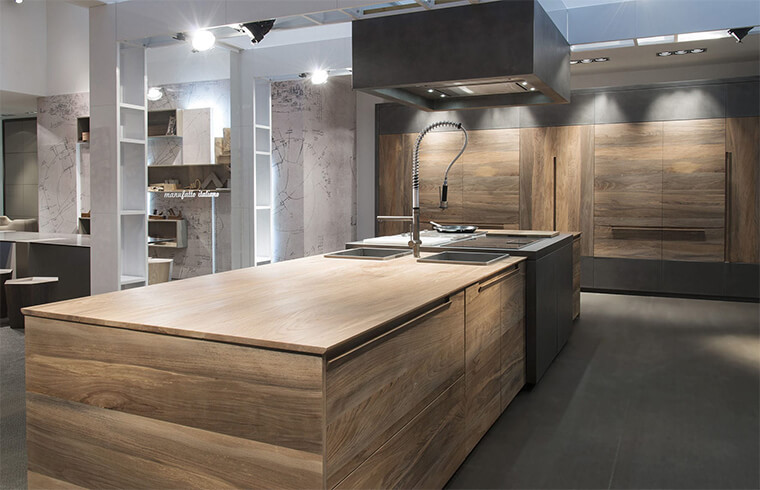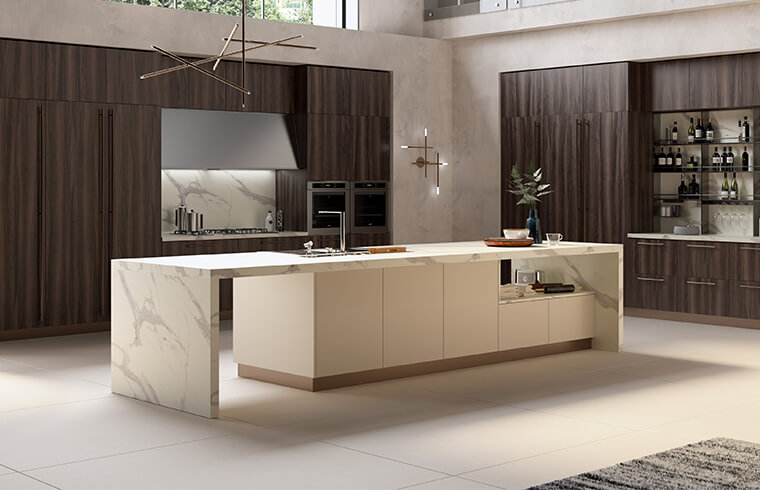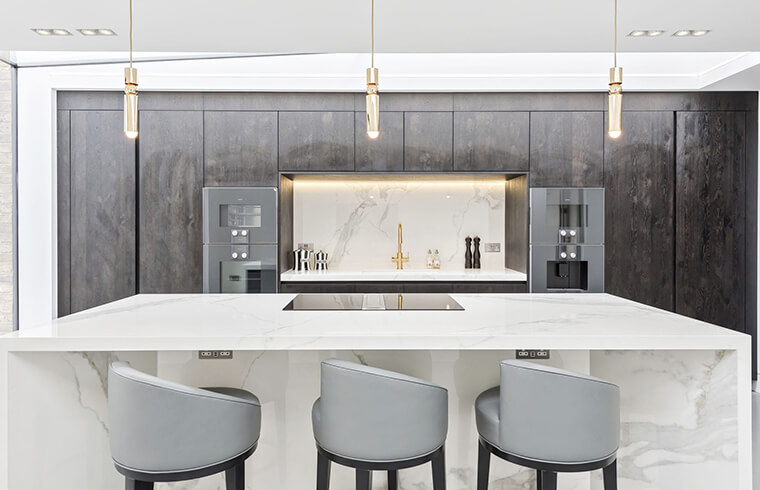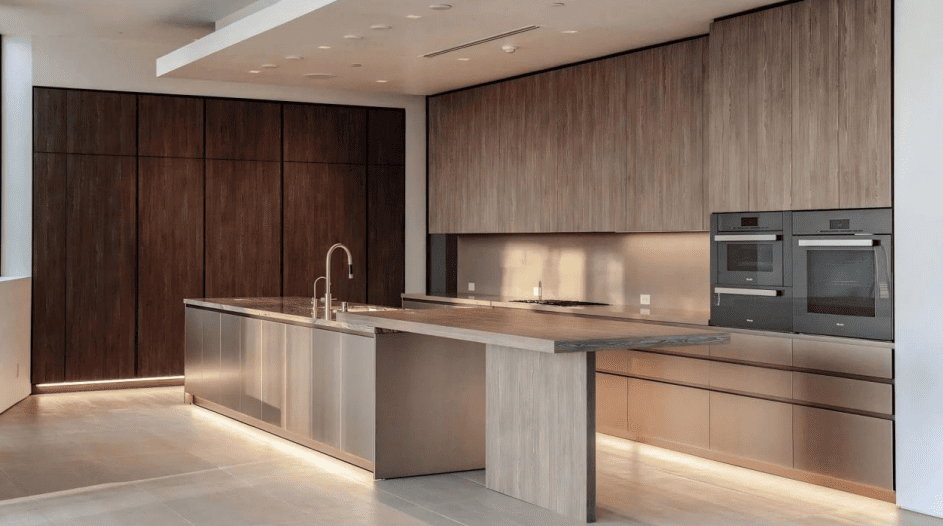Wood veneer cabinets have become increasingly popular among homeowners and designers alike due to their ability to provide the beauty of natural wood at a more affordable price. These cabinets offer an elegant, timeless aesthetic that enhances the visual appeal of any kitchen or living space. Additionally, wood veneer cabinets are a cost-effective alternative to solid wood, making them an attractive option for those looking to achieve a high-end look without breaking the bank. Beyond aesthetics and cost savings, wood veneer cabinets are also considered environmentally friendly, as they utilize thin slices of natural wood, reducing the amount of raw material required. As sustainability becomes a priority for many, choosing wood veneer cabinets can be seen as a responsible choice for both style-conscious and eco-conscious consumers.
At its core, wood veneer refers to thin slices of natural wood that are carefully peeled or sliced from a larger log. Unlike solid wood, which is made from a single, solid piece of wood, wood veneer involves adhering these thin sheets of wood onto a core material, typically engineered wood like MDF (Medium Density Fiberboard), HDF (High-Density Fiberboard), or plywood. This process allows the cabinets to mimic the appearance and texture of solid wood, while being more affordable and versatile in design. The main difference between wood veneer and solid wood is that veneer is not a single piece of wood but rather a thin layer bonded to a substrate.
The process of making wood veneer involves using specialized machinery to slice or peel the wood into thin sheets, which are then adhered to the substrate material using adhesives. The core materials, such as MDF or plywood, provide strength and stability, while the veneer layer gives the cabinet its wood-like finish. Commonly used core materials include MDF, HDF,and plywood, each offering different properties in terms of durability, moisture resistance, and weight. Understanding these materials is key to selecting the right wood veneer cabinet for your needs.

There are two primary types of wood veneer commonly used in cabinetry: natural wood veneer and artificial wood veneer.
Natural Wood Veneer: This is the real deal—thin slices of natural wood peeled or sliced from logs and adhered to a substrate. The beauty of natural wood veneer lies in its authenticity and the variety of wood species available, each with its unique grain, texture, and color. Popular wood types used in veneer production include walnut, oak, cherry, maple, and birch, among others. Each type offers its own distinct visual appeal. For example:
Walnut veneer has a rich, dark color with a smooth, even grain, making it a sophisticated choice for elegant and high-end spaces.
Oak veneer offers a light to medium color with prominent grain patterns, perfect for rustic or traditional interiors.
Cherry veneer has a reddish hue that deepens over time, creating a warm, inviting atmosphere in any room.
Artificial Wood Veneer: On the other hand, artificial or synthetic veneers are manufactured using printed images or laminates that replicate the look of natural wood. These veneers are less expensive and often used when budget constraints are a concern. While they lack the organic texture and character of real wood, they can offer a range of finishes and colors, making them an adaptable option for various design styles.
To better illustrate the diversity in wood veneer options, here's a table comparing some of the most common wood species used in cabinetry:
| Wood Type | Color | Grain Pattern | Ideal For |
|---|---|---|---|
| Walnut | Dark brown | Smooth, even grain | Elegant interiors |
| Oak | Light to medium brown | Prominent, coarse grain | Traditional and rustic spaces |
| Cherry | Reddish brown | Straight grain, smooth | Warm, inviting environments |
| Maple | Light cream | Fine, straight grain | Contemporary and modern designs |
| Birch | Pale yellow | Straight grain, even | Budget-friendly and versatile |

Wood veneer cabinets are often chosen for their numerous advantages, including cost-effectiveness, aesthetic appeal, eco-friendliness, and light weight.
Cost-Effective: One of the primary reasons homeowners opt for wood veneer cabinets is their affordability. Solid wood cabinets, while durable and aesthetically pleasing, can come with a hefty price tag. Wood veneer cabinets, however, provide the look of natural wood at a fraction of the cost. This makes them an ideal choice for budget-conscious homeowners who still want to achieve a luxurious appearance in their kitchen or bathroom.
Aesthetic Appeal: Wood veneer cabinets offer the same visual beauty as solid wood, with the added benefit of being available in a variety of finishes and wood species. The natural grain patterns, textures, and colors of the veneer create a sophisticated and timeless look that can complement a range of interior styles—from traditional to contemporary. With wood veneer, you can achieve the warmth and elegance of wood without the high price of solid wood cabinetry.
Eco-Friendly: Sustainability is a growing concern for many consumers, and wood veneer cabinets offer a more environmentally friendly option compared to solid wood. By using thin slices of wood rather than solid planks, wood veneer helps preserve forests and reduces the demand for large quantities of timber. The core materials used in veneer cabinetry are often made from recycled or sustainably sourced wood, further contributing to the eco-friendly nature of these cabinets.
Lightweight: Wood veneer cabinets are generally lighter than their solid wood counterparts, making them easier to handle and install. This can be particularly advantageous when renovating or moving into a new space, as it reduces the physical strain of transporting and installing heavy cabinetry.

While wood veneer cabinets offer many advantages, there are some limitations and challenges to consider before making your decision.
Maintenance Needs: One of the drawbacks of wood veneer is that it requires more regular maintenance than solid wood. The thin veneer layer can be susceptible to moisture damage, scratches, and dings. To keep veneer cabinets looking their best, it is essential to clean them regularly using a soft cloth and non-abrasive cleaners. Additionally, spills should be cleaned up immediately to avoid damaging the veneer layer.
Durability: While wood veneer cabinets are durable, they are not as strong as solid wood. The core materials, such as MDF or particleboard, are generally not as resilient as solid wood, which can lead to issues with longevity, especially in high-traffic areas or homes with young children. In comparison to solid wood, veneer cabinets may be more prone to warping or de-laminating under extreme conditions, particularly if exposed to excessive moisture or heat.
Repair Complexity: Another limitation of wood veneer is its repair complexity. While minor scratches and dents can often be fixed with touch-up kits or wood filler, more significant damage to the veneer layer may require professional repair or complete replacement. Unlike solid wood, which can be sanded and refinished multiple times, veneer cabinets have a limited lifespan in terms of refinishing.
When choosing cabinets, it’s important to understand the differences between wood veneer and other popular materials such as solid wood, particleboard/MDF, plywood, and laminate. Each option has its own set of advantages and disadvantages, depending on your needs for durability, aesthetics, and budget.
Below is a comparison table that highlights the key factors of each material:
| Material | Aesthetic Appeal | Durability | Cost | Maintenance | Environmental Impact |
|---|---|---|---|---|---|
| Wood Veneer | Natural wood look, wide variety of finishes | Moderate durability, susceptible to moisture damage | Affordable, budget-friendly | Easy to maintain, needs protection from moisture | Eco-friendly, uses less wood than solid wood |
| Solid Wood | Rich, timeless look, unique grain patterns | Very durable, long-lasting | Expensive | Requires regular maintenance, prone to scratches | Less eco-friendly, uses more wood |
| Melamine Laminates/HPL | Smooth, uniform surface | Less durable, can warp or swell with moisture | Very affordable | Easy to clean, vulnerable to moisture damage | Not very eco-friendly due to synthetic materials |
Wood veneer offers a balance between cost and aesthetics, providing the appearance of solid wood while being more affordable and environmentally friendly. However, its durability may not be as high as solid wood, and it requires proper care to maintain its appearance.

When selecting wood veneer cabinets, it’s important to focus on both quality and aesthetic appeal, ensuring that they meet your needs for style, durability, and functionality. Below are some tips to help you choose the best cabinets and maintain them effectively:
Examine the Veneer Layer: A good wood veneer cabinet should have a smooth, consistent veneer layer without any obvious gaps, bubbles, or peeling. Be sure to inspect the edges and seams to ensure the veneer is properly bonded to the substrate. The better the adhesive, the more durable the cabinet will be.
Check the Core Material: The core material plays a crucial role in the strength and durability of the cabinets. MDF (Medium Density Fiberboard) or plywood are typically the best choices for a sturdy and long-lasting base. Avoid particleboard, as it can be more prone to damage over time, especially in humid environments.
Look for Solid Construction: Ensure that the cabinet frames and doors are constructed well. High-quality wood veneer cabinets should be made with sturdy joinery, such as dovetail or mortise-and-tenon joints, rather than relying solely on nails or staples.
Select the Right Wood Species: Choose the wood species based on the aesthetic and durability needs of your space. For example, walnut and oak are beautiful and highly durable, while lighter woods like maple and birch are perfect for contemporary designs.
Consider the Finish: The finish of the veneer is another key factor in both the look and longevity of your cabinets. A high-quality finish will enhance the natural wood grain and protect the veneer from moisture and scratches. Choose a finish that matches your style—whether it's matte, satin, or gloss—and ensure it’s durable enough for everyday wear and tear.
Regular Cleaning: Keep your cabinets clean by dusting them regularly with a soft cloth or microfiber duster. Avoid using abrasive cloths or sponges, as they can scratch the surface of the veneer. For routine cleaning, use a mild soap solution and a damp cloth to wipe down the cabinet surfaces.
Prevent Moisture Damage: Wood veneer is sensitive to moisture, which can cause warping or peeling. Always wipe up spills immediately and avoid excessive moisture exposure. In areas prone to high humidity, such as kitchens or bathrooms, consider installing a dehumidifier or using moisture-absorbing products inside the cabinet to prevent damage.
Dust and Dirt Prevention: Dust can accumulate quickly on surfaces, dulling the appearance of the wood. Regularly clean the interior and exterior of your cabinets, and keep them free of dirt and grime. Consider adding a protective coating or wax to help repel dust and reduce maintenance over time.
Use Suitable Cleaners: When cleaning wood veneer, avoid harsh chemicals or abrasive cleaners that could damage the surface. Instead, opt for wood-specific cleaners that are gentle and designed to preserve the finish. Products containing beeswax or natural oils can also help maintain the sheen and condition of the wood.
Repairing Wood Veneer Cabinets: If your wood veneer cabinets become scratched or damaged, minor repairs can be made with a wood filler or touch-up pen. For deeper scratches, a veneer patch may be necessary. It’s important to match the color and grain pattern when repairing, so the repair blends seamlessly with the rest of the cabinet. For significant damage, you may need professional restoration to prevent further deterioration.
Wood veneer cabinets are a great option for many homeowners, offering a balance between cost, aesthetic appeal, and sustainability. However, whether they are the right choice for you depends on a variety of factors. Below is a comprehensive analysis to help you determine if wood veneer cabinets are the best fit for your needs:
For Budget-Conscious Consumers: Wood veneer cabinets provide a much more affordable alternative to solid wood while still offering the look and feel of real wood. If you're working with a budget but want to achieve a high-end, natural wood look, wood veneer is an excellent choice. The reduced cost doesn’t mean you have to compromise on style, as veneer cabinets come in a wide range of finishes and wood species.
For Style-Driven Homeowners: The aesthetic appeal of wood veneer is undeniable. With its rich, natural grain and variety of wood species, it can easily enhance the look of any kitchen or bathroom. Whether you prefer the deep hues of walnut or the lighter tones of maple, there is a veneer style to suit every interior design preference. Additionally, since the veneer is bonded to an engineered substrate, it allows for a more uniform look and can be produced in larger quantities, making it ideal for matching styles throughout the home.
For Eco-Conscious Consumers: Wood veneer cabinets are an environmentally friendly option. Since they use thin slices of wood rather than solid planks, they help reduce the demand for lumber and contribute to sustainable forest management. Choosing wood veneer is a responsible decision for those who are mindful of their environmental footprint, as it requires less wood and supports eco-friendly manufacturing processes.
For Those Prioritizing Durability: While wood veneer cabinets are relatively durable, they may not offer the same longevity as solid wood. If you’re looking for cabinets that will stand up to heavy use and last for decades, solid wood might be a better choice. However, with proper care and maintenance, wood veneer cabinets can last for many years.
For DIY Enthusiasts: Wood veneer cabinets can be easier to maintain than solid wood because they are generally lighter, making them easier to install or move. However, if repairs are needed, they can be more challenging to fix than solid wood. DIY enthusiasts may want to consider this before making a final decision.
Ultimately, whether wood veneer cabinets are the right choice for you depends on your budget, design preferences, and maintenance capabilities. They are a versatile, cost-effective, and eco-friendly option, but they may require more upkeep compared to solid wood cabinets. By considering the points outlined above, you can make a well-informed decision that meets both your practical and aesthetic needs.
What is a wood veneer cabinet?
A wood veneer cabinet is made by applying a thin layer of real wood to a core material, such as MDF or plywood. This gives the cabinet the appearance of solid wood without the higher cost and weight.
What are the advantages and disadvantages of wood veneer cabinets?
Advantages include cost-effectiveness, aesthetic appeal, and environmental benefits. Wood veneer cabinets are more affordable than solid wood while offering a similar look. They are also lighter and more sustainable. Disadvantages include the potential for damage from moisture and scratches, as well as the complexity of repairs if the veneer is damaged.
How do wood veneer cabinets compare to solid wood cabinets?
Wood veneer cabinets are more affordable and environmentally friendly than solid wood cabinets. They offer a similar aesthetic but may not be as durable or long-lasting as solid wood. Solid wood cabinets tend to be more resilient, but they also come at a higher price point and require more maintenance.
How do you maintain and repair wood veneer cabinets?
To maintain wood veneer cabinets, clean them regularly with a soft cloth, avoid harsh chemicals, and protect them from moisture. Minor scratches and dents can be repaired with wood filler or touch-up pens, but more significant damage may require professional restoration.
Looking for high-quality, customized cabinetry for your project? At BFP, we specialize in providing durable, cost-effective cabinet solutions tailored to your needs. Contact us today to explore our wide range of cabinet options!
We employ cookies to analyze website traffic and enhance your browsing experience. Data securely aggregated, privacy protected. See Privacy Policy for details.